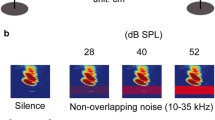Abstract
A stereotypical approach phase vocalization response of the lesser bulldog bat, Noctilio albiventris, to artificial echoes simulating a virtual approaching object was used to assess the ability of the bat to analyze and extract distance information from the artificial echoes. The performance of the bat was not significantly different when presented with naturally structured CF/FM echoes containing FM elements that sweep continuously from about 75-55 kHz in 4 ms or with CF/FM echoes containing FM components constructed from a series of 98 pure tone frequency steps, each with a duration of 0.04 ms. The performance of the bat remained unchanged when the duration of the tone steps was increased up to 0.08 ms but declined sharply to a level that was significantly below that seen with a naturally structured echo when the steps were 0.09 ms or longer. The performance of the bat depended on the duration of the individual tone steps, which could not exceed a specific upper limit of about 0.08 ms. The study suggests that the bats have adaptations for processing individual narrow band segments of FM signals over specific time intervals.
Similar content being viewed by others
Abbreviations
- CF:
-
constant frequency
- FM:
-
frequency modulation
References
Griffin DR (1958) Listening in the dark. Yale Univ Press, New Haven
Habersetzer J, Vogler B (1983) Discrimination of surfaced-structured targets by the echolocating bat Myotis myotis during flight. J Comp Physiol 152: 275–282
Masters WM, Jacobs SC (1989) Target detection and range resolution by the big brown bat (Eptesicus fuscus) using normal and time-reversed model echoes. J Comp Physiol A 166: 65–73
Roverud RC (1987) The processing of echolocation sound elements in bats: a behavioural approach. In: Fenton MB, Racey P, Rayner JMV (eds) Recent advances in the study of bats. Cambridge Univ Press, Cambridge, pp 152–170
Roverud RC (1993) Neural computations for sound pattern recognition: evidence for summation of an array of frequency filters in an echolocating bat. J Neurosci 13: 2306–2312
Roverud RC, Grinnell AD (1985a) Discrimination performance and echolocation integration requirements for target detection and distance determination in the CF/FM bat, Noctilio albiventris. J Comp Physiol A 156: 447–456
Roverud RC, Grinnell AD (1985b) Echolocation sound features processed to provide distance information in the CF/FM bat, Noctilio albiventris: evidence for a gated time window utilizing both CF and FM components. J Comp Physiol A 156: 457–469
Schmidt S (1988) Evidence for a spectral basis of texture perception in bat sonar. Nature 331: 617–619
Simmons JA (1973) The resolution of target range by echolocating bats. J Acoust Soc Am 54: 157–173
Simmons JA, Grinnell AD (1988) The performance of echolocation: acoustic images perceived by echolocating bats. In: Nachtigall PE, Moore PWB (eds) Animal sonar: processes and performance, Plenum, New York, pp 353–386
Simmons JA, Lavender WA, Lavender BA, Doroshaw CA, Keifer SW, Livingston R, Scallet AC, Crowley DE (1974) Target structure and echo spectral discrimination by echolocating bats. Science 186: 1130–1132
Simmons JA, Moss CF, Ferragamo M (1990) Convergence of temporal and spectral information into acoustic images of complex sonar targets perceived by the echolocating bat, Eptesicus fuscus. J Comp Physiol A 166: 449–470
Surlykke A (1992) Target ranging and the role of time-frequency structure of synthetic echoes in big brown bats, Eptesicusfuscus. J Comp Physiol A 170: 83–92
Vaughan TA (1970) Flight patterns and aerodynamics. In: Wimsatt WA (ed) Biology of bats, vol I. Academic Press, New York, pp 195–216
Author information
Authors and Affiliations
Rights and permissions
About this article
Cite this article
Roverud, R.C. Complex sound analysis in the lesser bulldog bat: evidence for a mechanism for processing frequency elements of frequency modulated signals over restricted time intervals. J Comp Physiol A 174, 559–565 (1994). https://doi.org/10.1007/BF00217376
Accepted:
Issue Date:
DOI: https://doi.org/10.1007/BF00217376




